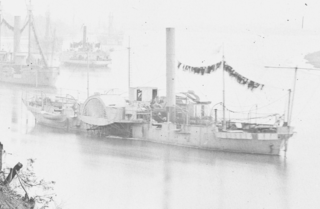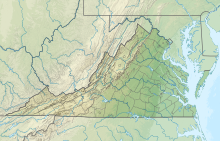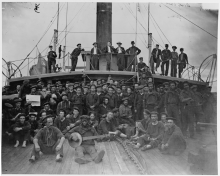
The Battle of Nashville was a two-day battle in the Franklin-Nashville Campaign that represented the end of large-scale fighting west of the coastal states in the American Civil War. It was fought at Nashville, Tennessee, on December 15–16, 1864, between the Confederate Army of Tennessee under Lieutenant General John Bell Hood and the Union Army of the Cumberland (AoC) under Major General George H. Thomas. In one of the largest victories achieved by the Union Army during the war, Thomas attacked and routed Hood's army, largely destroying it as an effective fighting force.

Franklin Buchanan was an officer in the United States Navy who became the only full admiral in the Confederate Navy during the American Civil War. He also commanded the ironclad CSS Virginia.
USS Alert was a 90 long tons (91 t) steamship named A. C. Powell purchased by the Union Navy during the first year of the American Civil War.

John Rodgers was an admiral in the United States Navy. He began his naval career as a commander in the American Civil War and during his postwar service became an admiral.

The first USS Miami was a side-wheel steamer, double-ender gunboat in the United States Navy during the American Civil War.

Charles Williamson Flusser was an officer in the United States Navy during the American Civil War.

CSSEllis was a gunboat in the Confederate States Navy and the United States Navy during the American Civil War. It was lost during a raid while under command of famed Navy officer Lieutenant William B. Cushing.

CSS Teaser had been the aging Georgetown, D.C. tugboat York River until the beginning of the American Civil War, when she was taken into the Confederate States Navy and took part in the famous Battle of Hampton Roads. Later, she was captured by the United States Navy and became the first USS Teaser.
The Battle of Sewell's Point was an inconclusive exchange of cannon fire between the Union gunboat USS Monticello, supported by the USS Thomas Freeborn, and Confederate batteries on Sewell's Point that took place on May 18, 19 and 21, 1861, in Norfolk County, Virginia in the early days of the American Civil War. Little damage was done to either side. By the end of April 1861, USS Cumberland and a small number of supporting ships were enforcing the Union blockade of the southeastern Virginia ports at the southern end of the Chesapeake Bay and had captured several ships which attempted to pass the blockade. USS Monticello's bombardment of the Sewell's Point battery was one of the earliest Union Navy actions against Confederate forces during the Civil War. While it has been suggested by some sources that the Monticello's action may have been the first gunfire by the Union Navy during the Civil War, a brief exchange of cannon fire between the U.S. gunboat USS Yankee and shore batteries manned by Virginia volunteer forces which had not yet been incorporated into the Confederate States Army at Gloucester Point, Virginia on the York River occurred on May 7, 1861.

The Red River campaign, also known as the Red River expedition, was a major Union offensive campaign in the Trans-Mississippi theater of the American Civil War, which took place from March 10 to May 22, 1864. It was launched through the densely forested gulf coastal plain region between the Red River Valley and central Arkansas towards the end of the war. The offensive was intended to stop Confederate use of the Louisiana port of Shreveport, open an outlet for the sugar and cotton of northern Louisiana, and to split the Confederate lines, allowing the Union to encircle and destroy the Confederate military forces in Louisiana and southern Arkansas. It marked the last major offensive attempted by the Union in the Trans-Mississippi Theater.

USS Commodore Perry was a 512-long-ton (520-tonne) steamer acquired by the Union Navy in 1861, the first year of the American Civil War. She was named after Commodore Oliver Hazard Perry (1785–1819), a naval officer who had commanded American forces on Lake Erie in the War of 1812. In January–February 1862, Commodore Perry was part of the North Atlantic Blockading Squadron, taking part in the attack, in cooperation with the Union Army, which resulted in the surrender of Roanoke Island by the Confederate States of America. She participated in several other campaigns through 1862, including the capture of Elizabeth City, North Carolina, and army–navy expeditions against Franklin, Virginia, and Hertford, North Carolina. From 1863 until the end of the war, she was engaged in patrols, both inland and in Virginia coastal waters.

Samuel Perry "Powhatan" Carter was a United States naval officer who served in the Union Army as a brigadier general of volunteers during the American Civil War and became a rear admiral in the postwar United States Navy. He received a nomination for appointment to the grade of brevet major general on January 13, 1866, two days before he was mustered out of the volunteers, to rank from the omnibus date of March 13, 1865. The nomination was confirmed by the United States Senate on March 12, 1866. He was the first and thus far only United States officer to have been commissioned both a general officer and a Naval flag officer.

The siege of Suffolk, also known as the Battle of Suffolk, took place from April 11 to May 4, 1863, near Suffolk, Virginia during the American Civil War.
Daniel Lakin was a Medal of Honor recipient in the Union Navy from 1861–1865

The military forces of the Confederate States, also known as Confederate forces, were the military services responsible for the defense of the Confederacy during its existence (1861–1865).
USS Emily was a Union steamer during the American Civil War.
Hispanics in the American Civil War fought on both the Union and Confederate sides of the conflict. Not all the Hispanics who fought in the American Civil War were "Hispanic Americans" — in other words citizens of the United States. Many of them were Spanish subjects or nationals from countries in the Caribbean, Central and South America. Some were born in what later became a U.S. territory and therefore did not have the right to U.S. citizenship. It is estimated that approximately 3,500 Hispanics, mostly Mexican-Americans, Puerto Ricans and Cubans living in the United States joined the war: 2,500 for the Confederacy and 1,000 for the Union. This number increased to 10,000 by the end of the war.
The 11th Pennsylvania Cavalry was a cavalry regiment that served in the Union Army during the American Civil War.

The Wytheville Raid or Toland's Raid was an attack by an undersized Union brigade on a Confederate town during the American Civil War. Union Colonel John Toland led a brigade of over 800 men against a Confederate force of about 130 soldiers and 120 civilians. The location of Wytheville, the county seat of Wythe County in southwestern Virginia, had strategic importance because of a nearby lead mine and the railroad that served it. This mine supplied lead for about one third of the Confederate Army's munitions, while the Virginia & Tennessee Railroad transported Confederate troops and supplies; plus telegraph wires along the railroad line were vital for communications. In addition to logistics of moving the lead to bullet manufacturing facilities, this rail line also connected an important salt works of an adjacent county with the wider Confederacy.

The 7th Massachusetts Battery was an artillery battery that served in the Union Army during the American Civil War. The original core of the unit was a company of infantry known as the Richardson Light Guard. The company initially served provost duty at Fortress Monroe, was eventually trained in light artillery drill, and reorganized on March 17, 1862 as the 7th Massachusetts Battery.





















